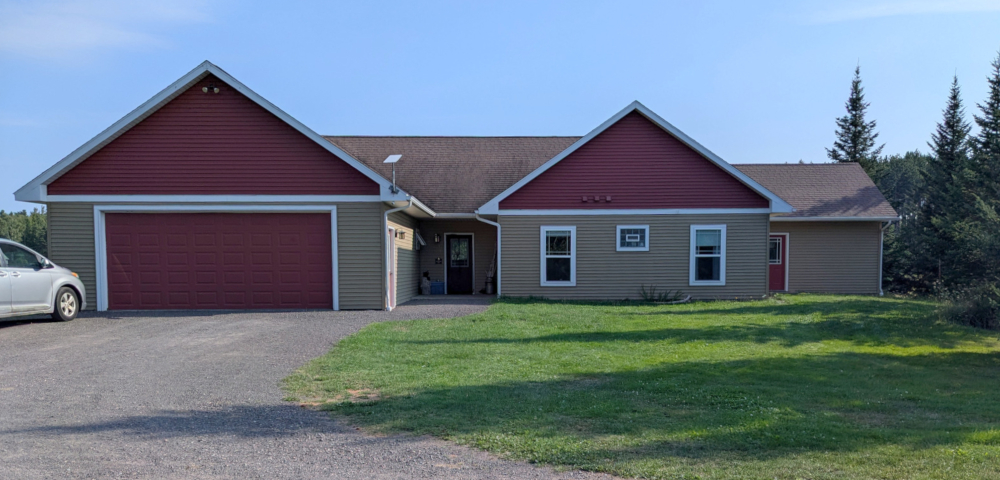Why building an accessible home was the right choice for us
We're sometimes asked to describe our design considerations and experience

Sometimes people reach out to me or my husband, Todd, to get our advice on building an accessible home. We share with them what we’ve learned over the past 14 years with his ALS and progressive disability.
After Todd was diagnosed, we realized that we’d need to sell our house. We loved our 1925 Craftsman bungalow, but it wasn’t accessible, and remodeling it would’ve ruined its character and still left us with something less than ideal. We also decided that we should relocate to my native state, Michigan, to be near my parents so we’d have family support as the disease progressed. We put our house on the market and planned our next steps.
We visited a woman who’d lost her husband to ALS two years prior. They’d built an addition with one large room covered with low-pile carpet and an accessible bathroom. The bathroom had space on each side of the toilet and a deep and wide roll-in shower. The first level of their house and the addition weren’t at ground level, so they installed a wheelchair lift in their garage. It was helpful to see someone’s setup while we were trying to wrap our minds around what lay ahead.
We first looked in and around my hometown for a house to buy, but none was ideal. We would’ve needed to build ramps or install lifts, and none of the bathrooms were accessible.
Creating our own house
We decided to build new, and Todd bought consumer-grade software to design a house plan. We included key aspects of accessibility, such as a 4-foot-wide hallway, 36-inch doors, and an accessible bathroom.
After our bungalow finally sold, we prepared to build on the corner of my parents’ property, a short walk across the field from my childhood home. We chose a builder, and he turned our plans into architectural drawings.
We then selected other features for comfort and accessibility. Radiant floor heating, for example, keeps immobile feet warm. Levered door handles and fixtures extend independence. Solid surface flooring throughout the house prevents tripping and allows for easier movement of a wheelchair. Flat transition strips between flooring types are preferred because even small bumps jostle a weak neck if a head array is used to control a wheelchair. A roll-out patio allows Todd to get outside and enjoy our backyard.
When people reach out to us, we share the design elements that we incorporated into our home. We also share a video we made about our accessible bathroom design: space to turn around in a wheelchair; a chair-height toilet with an elongated bowl; a roll-in, zero-barrier shower with a trench drain; and a roll-under sink.
We also share a few other considerations:
Is new construction or remodeling worth the expense and time? When the disease progresses quickly, and especially when people choose not to have interventions, there may not be time to remodel a home or make a big move. In these difficult situations, people often make do with a hospital bed and commode in the living room.
What will the caregiving spouse do when his or her duties are over? In our case, Todd and I knew we’d want to be near my parents so I’d have their help with our young children during and after the disease, so a move made sense for us.
What will life look like if you have additional caregivers in the house? Can you plan for an area where the spouse and children can have their own space, separate from the part of the house where the person with ALS has medical professionals and caregivers coming and going? We didn’t anticipate needing to have nighttime caregivers. Four years after our initial build, we added an office off of Todd’s bedroom so caregivers can sit within earshot of him at night.
Building is expensive, and we needed to fundraise and take an early withdrawal from Todd’s 401(k) to minimize the amount we mortgaged. But accessible designs aren’t necessarily significantly more expensive than a standard design. Many house plans can be adapted with minor layout changes and the proper selection of fixtures.
The expense and time spent building our accessible home have improved Todd’s and our family’s quality of life. Plus, it was fun to create something together.

Our accessible home. (Photo by Kristin Neva)
Note: ALS News Today is strictly a news and information website about the disease. It does not provide medical advice, diagnosis, or treatment. This content is not intended to be a substitute for professional medical advice, diagnosis, or treatment. Always seek the advice of your physician or other qualified health provider with any questions you may have regarding a medical condition. Never disregard professional medical advice or delay in seeking it because of something you have read on this website. The opinions expressed in this column are not those of ALS News Today or its parent company, Bionews, and are intended to spark discussion about issues pertaining to ALS.







Mary Douglas
My new accessible home is built on a street where I had lived 31 years bye a semi-retired builder who was sympathetic due to having a child with cancer many years ago. Before finding him building eight other houses on my street, I lost time with three other builders who did not have the mindset to listen to my needs.
My home has many of the features described by Kristen Neva which are displayed in the book Accessible Home by Diane Pierce. Master bathroom, bedroom and office have pocket doors. The latter is the size of a barn door with two pocket doors which are less expensive than Barn doors. This wide opening is so easy to turn a wheelchair around in. It is my office. There is about a 16x14 rear deck and a similar front porch with the very large kitchen sink window overlooking the porch. This allows me to see who is knocking at the door. However the front door is at an angle that most knockers do not notice me. The lot is only 50 ft wide by 140 ft deep. I would have preferred a wider garage and master bathroom by 2 ft but there was not space.
I would like to focus on things I would change. Many of them would have taken much longer to find the helpful features I will describe. 1) kitchen and bathroom sinks with faucets position at the front side to be easy to reach. 2) screening on the front porch with a saloon style double swinging door that I could push open while in wheelchair with my feet. 3) receptacles are about 30 in high. By placing them near molding instead of where furniture is located my wheelchair could access them without bumping the furniture. 4) I was new to the wheelchair when I moved in and so scraped moulding in many places. It would have been useful to attach foam rubber strips to the sides of wheelchair arms until I learned how to negotiate doors. 5) The front door and deck door I use less because it takes so many rotations to reach the handle, and I have not found ropes attached to the handle any easier. Too many mosquitoes get in the doors while I am rotating. Being outdoors is so refreshing the door problem is a loss I feel. I recently sold my car. I am anticipating using the garage door
remote to enter and exit the front. My builder charged extra for BR, BA, linen, and laundry closet shelving. I find storage essential to avoid clutter in my wheelchair path and because I have so much more equipment to store. I was advised to have the vinyl flooring glued down due to the weight of the wheelchair. The installers were unaccustomed to this step and did not clean off the glue as well as they should have. A major compromise I had to accept is
not being able to reach the backyard due to the steep rear drop of the lot. Having a whole house generator installed has given me piece of mind. All in all I enjoy my house greatly each day. I planned much of the space around furniture I already had. I think a semi circular rather than a square island in the kitchen would have been easier to navigate. I had the dream of building a house for 20 years before I did so. My home is in familiar surroundings so I did not have to learn the territory and and neighbors. It is in the city Paratransit van service area. I would love to see a video of the Neva floor plan.